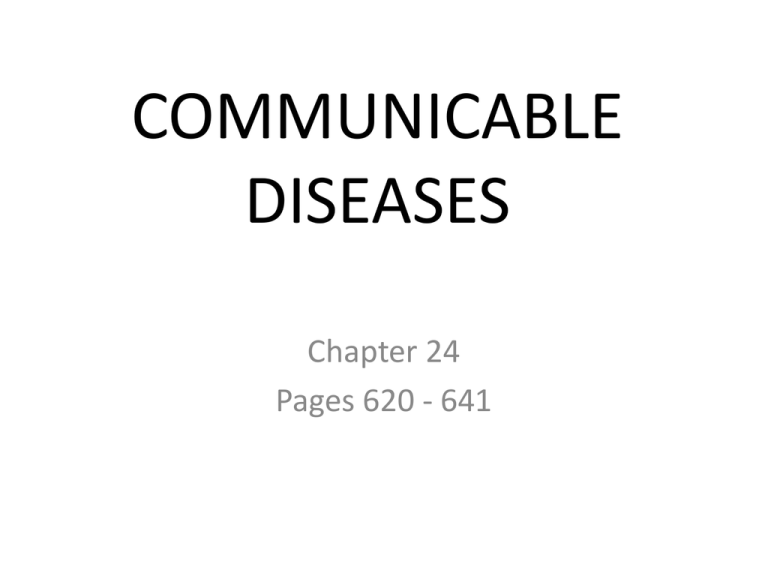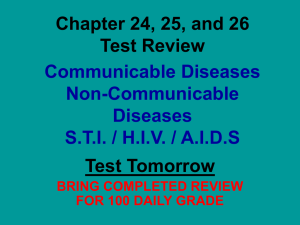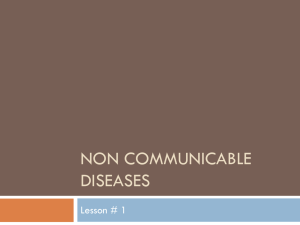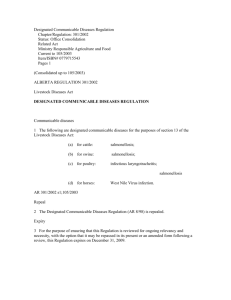COMMUNICABLE DISEASES
advertisement

COMMUNICABLE DISEASES Chapter 24 Pages 620 - 641 What I need to know about Communicable Diseases: 1. Causes of Communicable Diseases 2. How Communicable Diseases are Transmitted 3. Preventing the Spread of Disease CAUSES OF COMMUNICABLE DISEASES VIRUSES •Common Cold •Flu •Viral Pneumonia •Viral Hepatitis •Polio •Mono •Measles •AIDS •Viral Meningitis •Chicken Pox •Herpes •Rabies •Small Pox BACTERIA •Bacterial Foodborne Illness •Strep Throat •Tuberculosis •Diptheria •Gonorrhea •Lyme Disease •Bacterial Pinkeye •Bacterial Pneumonia •Bacterial Meningitis FUNGI •Athlete’s Foot •Ringworm •Vaginal Yeast Infection PROTOZOANS •Malaria •Amoebic Dysentery •Sleeping Sickness *Chart Found on Page 623 in your health book* RICKETTSIAS •Typhus •Rocky Mountain Spotted Fever Viruses – usually run their course and eventually killed by your immune system. Can’t be treated by antibiotics Bacteria – are usually destroyed by your immune system. Can be treated by antibiotics. Rickettsias – enter humans through bites of insects (flees or lice). How Communicable Diseases are Transmitted: Direct Contact Indirect Contact Airborne Transmission •Touching •Biting •Kissing •Sexual Contact •Sneezing •Coughing •Pregnant Women can pass disease to unborn child through placenta •Contaminated Objects •Vectors (flies, mosquitoes, ticks) •Water and Food •Travel through the air for a long time or distance •Don’t settle quickly on surfaces Preventing the Spread of Communicable Diseases Eat a Balanced Diet Washing Hands Handling Food Properly Don’t share utensils, makeup, combs, brushes or other personal items Be sure to get vaccinations Take care of yourself when you are ill (cover your mouth when you cough/sneeze) Regular Physical Activity Avoid unnecessary contact with people who are ill. Avoid Alcohol, Tobacco, and other drugs Learn to manage stress PREVENTING COMMUNICABLE DISEASES Physical & Chemical Barriers • 1st line of defense •Physical: skin, mucous membranes •Chemical: enzymes in tears PREVENTING COMMUNICABLE DISEASES The Immune Response • Pathogens invade the body. •Macrophages engulf the pathogen. •Macrophages digest the pathogen and T cells recognize antigens of the pathogen as an invader. •T cells bind to the antigens. •B cells bind to antigens and helper T cells •B cells produce plasma cells. •Plasma cells release antibodies into the bloodstream. •Antibodies bind to antigens to help other cells identify and destroy pathogens. *Found on page 630 in Health Book* COMMON COMMUNICABLE DISEASES Respiratory Infections •Common Cold •Influenza •Pneumonia •Strep Throat •Tuberculosis Hepatitis Other •Hepatitis A •Hepatitis B •Hepatitis C •Mononucleosis •Measles •Encephalitis •Meningitis NONCOMMUNICABLE DISEASES Chapter 26 Pages 674 - 699 CARDIOVASCULAR DISEASES Hypertension – high blood pressure • Normal blood pressure: 110-120/50100 • Normal Heart Rate: 55-105 • Common among people over the age of 35 • “Silent Killer” because it often has no symptoms. • Treatment: medication, weight management, physical activity & proper nutrition CARDIOVASCULAR DISEASES Atherosclerosis – plaques accumulate on artery walls. • Buildup is due mainly to food choices. • Can cause blood clots that can lead to heart attack or strokes. DISEASES OF THE HEART Angina Pectoris – chest pain that results when the heart does not get enough oxygen • Last from seconds to minutes • Warning sign that the heart is temporarily not getting enough blood • Treatment: medication DISEASES OF THE HEART Arrhythmias– irregular heart beats • Skip a beat • Beat irregularly • Beat very quickly • Beat very slowly DISEASES OF THE HEART Heart Attack – damage to the heart muscle caused by a reduced or blocked blood supply. • Many heart attacks are sudden & cause intense chest pain DISEASES OF THE HEART Congestive Heart Failure – heart weakens and can’t maintain its regular pumping rate and force. • Gradually weakens • Can be result of high blood pressure, atherosclerosis, a heart valve defect or other factors • Management (not treatment): medication, good nutrition, physical activity. DISEASES OF THE HEART Stroke – arterial blockage interrupts the flow of blood to the brain. • Brain is deprived of oxygen • Cerebral Hemorrhage – blood vessels in brain burst. DIAGNOSTIC TOOLS EKG MRI Produces a graph of the electrical activity of the heart. It helps detect the nature of a heart attack and shows heart function. Uses powerful magnets to produce images of internal body organs. The images are used to identify heart damage and heart defects. Radionuclide Imaging Radionuclides injected into the blood can be observed on a computer screen as they pass through the heart. Used to assess the heart’s blood supply and to show heart function. Angiography A thin, flexible tube is guided through blood vessels to the heart. Dye is injected, and motion x rays are taken to look for heart obstructions. TREATMENT OPTIONS Coronary Bypass Often a healthy vein is removed from the leg or chest and placed elsewhere to create a detour around a blocked artery. Angioplasty Medications Pacemaker A tube with a balloon is inserted into a blocked artery. The balloon is inflated against the artery walls. Then it is deflated and removed. A metal structure may remain to keep the artery open. Various medications are used to treat CVDs. These include diuretics to aid with the body’s fluid balance, cholesterol-lowering drugs, and drugs that slow the blood’s clotting mechanisms in order to reduce risk of stroke. Pacemakers are used to treat an irregular heartbeat. The small device sends steady electrical impulses to the heart to make it beat regularly. Why Teens Can Be At Risk For Cardiovascular Diseases: • History of smoking or diabetes, blood-vessel damage • Health behaviors you practice NOW are affecting your cardiovascular system • Physical Activity • Nutrition Risk Factors for Cardiovascular Disease YOU CONTROL • Tobacco Use • High Blood Pressure • High Cholesterol • Physical Inactivity • Excess Weight • Stress • Drug & Alcohol Use YOU DON’T CONTROL • Heredity • Gender • Men have greater risk • Women of same age don’t recover as well as men • Age CANCER Uncontrollable growth of abnormal cells TYPES OF CANCERS Lymphomas Leukemias Carcinomas Sarcomas Cancers of the Immune System. Cancers of the blood-forming organs. Cancers of the glands and body linings, including the skin and the linings of the digestive tract and lungs. Cancers of connective tissue, including bones, ligaments and muscle. Risk Factors for Cancer • Abnormal cells that have the potential to become cancer cells are produced every day and the immune system destroys most of them. • If the immune systems becomes weakened or the number of cancer cells becomes overwhelming, cancer may develop. • Some cases – normal cells may change by themselves, in others it is due to a faulty gene. • Majority of cancers are caused by exposure to certain factors that increase the risk of cell damage. • Carcinogen from cigarette smoke • Ultraviolet light (tanning) • Sexually Transmitted Diseases • Dietary factors How to reduce our risk for Cancer • Practice abstinence from sexual activity • Be physically active • Maintain a healthy weight • Eat nutritious foods • Follow an eating plan that is low in saturated fat and high in fiber • Protect your skin from ultraviolet radiation • Avoid tobacco and alcohol • Recognize warning signs of cancer Treatment for Cancer • Surgery • Radiation Therapy • Chemotherapy • Immunotherapy • Hormone Therapy A word of CAUTION about cancer Change in bowel habits A sore that does not heal Unusual discharge or bleeding Thickening or a lump in breast or other part of the body Indigestion or difficulty swallowing Obvious change in a wart of mole Nagging cough or hoarseness ALLERGIES Common Allergens: pollen, food, dust, mold spores, chemicals, insect venom, medicines. Histamines produce: sneezing, itchy eyes, runny nose Reactions: Hives, swelling of the mouth, difficulty breathing/swallowing, raspy voice, swelling of the tongue, blood pressure drops Diagnosing Allergies: Blood test, food elimination diet, skin test Treating Allergies: avoiding the allergens, medicines with antihistamines, immunotherapy (series of shots) ASTHMA Common Asthma Triggers: air pollution, pet dander, tobacco smoke, microscopic mold, pollen, dust mites. 1. 2. 3. 4. • • • • Asthma Attacks: Muscles of the bronchial walls tighten and produce extra mucus. Respiratory passages narrow. Results can range from minor wheezing to severe difficulty in breathing. Can be life threatening Managing Asthma: Monitor the condition: (shortness of breath, chest tightness or pain, coughing/sneezing Manage the environment: avoid exposure to tobacco smoke Manage stress: Relax Take medication: can be used to relieve symptoms or prevent flareups. DIABETES Serious side effects: Blindness Kidney Failure Limb Amputations Heart Disease Stroke DIABETES Type 1 Diabetes: body does not produce insulin and glucose builds up in the blood starving cells of the energy they need. Treatment for Type 1 Diabetes: Must take daily doses of insulin either through injections or a special pump attached to the body by tubing that is surgically implanted. Accounts for 5-10% of all diabetes cases. DIABETES Type 2 Diabetes: found in older adults and in individuals that are obese or have inactive lifestyles. Treatment for Type 2 Diabetes: weight management and regular physical activity. Carefully monitor diet to control blood-sugar levels. Some cases, oral medicines or injections. Accounts for 90-95% of all diabetes cases. ARTHRITIS Osteoarthritis – cartilage breaks down. Affects mainly the weight bearing joints of the knees and hips, but can affect any joint including fingers, lower back, and feet. Treatment of Osteoarthritis: Controlling weight, preventing sports injuries, protecting against Lyme Disease. Rheumatoid Arthritis – Caused by an autoimmune disease, which has no cure. Sufferers are likely to experience inflammation, swelling, stiffness, and joint pain. Joints may become deformed and cease to function properly. Affects mainly the joints in the hand, foot, elbow, shoulder, neck, knee, hip, and ankle. Treatment of Rheumatoid Arthritis: Focus on relieving pain, reducing inflammation and swelling, and joints moving as normally as possible. A combination of exercise, rest, joint protection, and physical and occupational therapy. PHYSICAL AND MENTAL DISABILITIES Sight Impairments Hearing Impairments Motor Impairments Mental Challanges SIGHT IMPAIRMENT Macular Degeneration: a disease in which the retina degenerates. It is the leading cause of blindness in individuals over 55. Glaucoma: a disease that damages the optic nerve of the eye. Cataracts: a clouding of the lens of the eye. HEARING IMPAIRMENT • Can range from minor to severe • Profound Deafness: hearing loss so severe that a person affected cannot benefit from mechanical amplification, such as a hearing aid. Causes of Deafness • • • • Heredity Injury Disease Obstructions • Build-up of wax • Bone blockage • Something stuck in the ear • Surgery can cure many obstructions • Nerve Damage • Age • Loud Noises (stereos, traffic, video games, machines, concerts) MOTOR IMPAIRMENT • Results when the body’s range of motion and coordination are affected by an injury to the brain or a disorder of the nervous system. • Physical Therapy is often used to help those with motor impairments. MENTAL RETARDATION Causes: • • • • • • • • Injury Disease Brain Abnormality Genetic Disorder • Down Syndrome • PKU • Tay-Sachs • Fragile X Syndrome Pregnant women who use Alcohol or other Drugs • Low birth weight • Mental Retardation • Fetal Alcohol Syndrome Restricted supply of oxygen during birth Stroke Certain infections • Meningitis ACCOMMODATING FOR DIFFERENCES • Wheelchair access on public transportation and building entrances • People are evaluated based on merit, not on stereotyped assumptions about disabilities • People should have the same opportunities as people who do not have physical or mental challenges.






